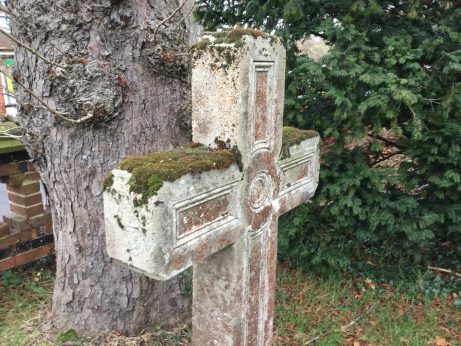TQ31E had no records when I started to look at the tetrads in TQ31 with a view to turn them all green (an aim achieved when at east 40 taxa had been recorded in each). But the tetrad was daunting: a built-up area with very few bits of habitat that might yield a good variety of taxa. Earlier this year I visited a garden backing on to the railway with permission from the owners who my husband knew because they had a bat roost. This was quite a promising start with several woodland and grassland taxa surviving, as well as a surprising amount of Conocephalum conicum at the entrance to a damp tunnel. I found Bryum radiculosum at the base of the front wall of the house. I then went on to the reclamation centre by the station and found Homalothecium sericeum and Hypnum lacunosum on a huge limestone boulder as well as common acrocarps in the rubbly car park. Altogether I recorded 20 taxa that day but did wonder about the species on the boulder – someone could buy it and take it away. I made a note to revisit some time.

I resumed the exploration of the area recently by visiting brick-built St John’s church. Its walls hosted no bryophytes but the monuments and adjacent soil were more interesting, adding with Hypnum resupinatum, Didymodon rigidulus and D. sinuosus to the list among other common taxa. A weeping form of ash had large cushions of Orthotrichum affine and Cryphaea heteromalla but all the other trees were bryophyte-bare. The list was now up to 33.

Dog-walking terrain between houses and the railway line.
It wasn’t until two days before Christmas that I had another opportunity to try to augment the list. A bit of grassland and woodland near Wivelsfield station bordered by houses and a railway line had somehow escaped development. I parked on a nearby road and found Syntrichia intermedia, Didymodon luridus and Bryum argenteum among another expected pavement species and fruiting Grimmia pulvinata and Tortula muralis on garden wall tops. The grassland was tussocky and not good moss habitat but I found a Bryum sp. that that I didn’t recognise on an adjacent railway bridge that was edged by vegetation and various assorted debris. At home, under the microscope I found it had numerous filamentous gemmae about 30 microns wide, which led me to believe it was Bryum moravicum. But it was not in typical habitat (trunks or branches of trees) and, never convinced of my tentative identifications of Bryum spp., I sent it to Tom who confirmed it and added his usual and valuable identification tips. The leaves are similar in outline to other members of the group that includes Bryum capillare but have a shorter apiculus. Another member of the group, Bryum donianum, also occasionally has gemmae but Tom checked that the specimen I sent had unistratose margins rather than the bistratose ones of B. donianum. In R. Braithwaite’s The British Moss Flora (1887) B. moravicum was listed as a Bryum capillare var. flaccidum recorded by Davies, among others, at Newtimber in Sussex.

Bridge over the London to Brighton railway with Bryum moravicum on debris along the edge.
In the sparse woodland few trees bore epiphytes but branches of an old ash tree was had patches of Syntrichia papillosa, with the tips of the leaves bearing of shiny green gemmae balls, among more common taxa such as Orthotrichum affine and Hypnum spp. A hawthorn nearby had large patches of Cololejeunea minutussima.


Syntrichia papillosa from R. Braithwaite’s The British Moss Flora (1887) recorded in Sussex at Hurstpierpoint by Mitten and Newtimber by Davies in 1857
So now the list for the tetrad stands at 43 taxa but I think that the Homalothecium sericeum and Hypnum lacunosum on the large chalk boulder should be removed from the records because when I checked on my way home the boulder had gone and is, presumably, now part of some other landscape.
Advertisements Share this:




